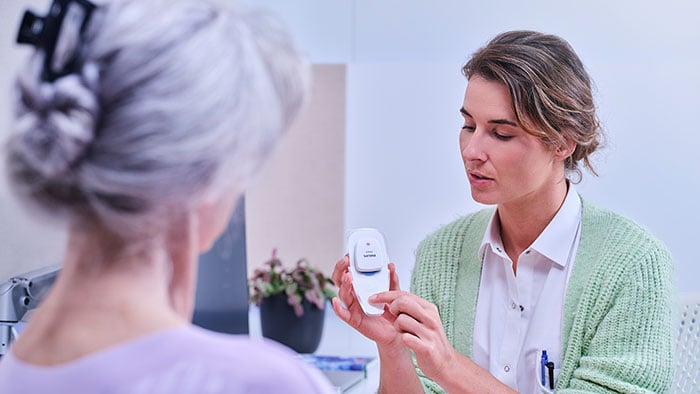Philips calls for global action on stroke awareness and access to life-saving care
Oct 23, 2024 | 3 minute read
During the recent United Nations General Assembly (UNGA) in New York, the World Stroke Organization, Philips and Medtronic Neurovascular hosted a high-level side event to emphasize the urgent need to address global disparities in stroke care, the number two cause of mortality in the world. The event emphasized the importance of prevention, risk factor control, access to timely treatment and rehabilitation in reducing the global burden of stroke [1]. Joining were Ministry of Health leaders from 8 nations, representatives from the UN, the G20 and G7 Health Development Partnership, leading neurointerventional physicians, and the BCIU (Business Council for International Understanding).

Dr. Atul Gupta, Chief Medical Officer for Diagnosis & Treatment at Philips, and Signe Haughton, Senior Director, Medical & Government Affairs and Chief of Staff at Medtronic Neurovascular, provided opening words outlining today’s clinical and economic challenges – and opportunities-- in stroke treatment, and shared a vision for the future. Despite stroke being the second leading cause of death and a major cause of long-term disability, governmental investment in stroke treatment and networks lags markedly and disproportionately behind other diseases. With only 5% of eligible stroke patients globally receiving the lifesaving, potentially stroke-reversing procedure known as mechanical thrombectomy, the event served as a rallying cry for action.
“Every two seconds, someone on Earth has a stroke, yet only a small percentage of our global population has access to mechanical thrombectomy, a minimally invasive treatment which can potentially reverse stroke-- if performed quickly enough,” said Dr. Atul Gupta. “We need to ensure that where you live doesn’t dictate whether you live.” Signe Haughton highlighted the staggering economic and societal costs associated with stroke care worldwide, which if the current trends in stroke incidence and treatment continue, will rise significantly. A projected $1.6 trillion annually [2] is foreseen for both the direct medical expenses and the indirect costs, such as lost productivity and long-term disability. These are precious funds that could be diverted to other diseases if countries make investment today into stroke networks and thrombectomy centers.

Professor Sheila Martins, President of the World Stroke Organization, then moderated a panel session between Ministry of Health leaders from 8 nations, Dr. Atul Gupta, and Signe Haughton. Professor Martins stressed the urgent need for coordinated efforts across governments, societies, industry leaders and health-care leaders to combat this global stroke crisis.
A call to action: Building a global network for stroke care
The event highlighted the need for stronger public-private partnerships to put more emphasis on prevention, risk factor control and to create comprehensive stroke care networks, with a focus on three key areas:
Time is brain: Every second counts
Stroke is a race against time. The panel emphasized that comprehensive stroke networks, enabled by advanced technology and digital solutions, can drastically reduce treatment times and improve patient outcomes. Yet, the current infrastructure remains inadequate in many regions, resulting in delays that contribute significantly to poor outcomes. Achieving the United Nations Sustainable Development Goal (SDG) 3.4—reducing mortality from non-communicable diseases by one-third by 2030—will be impossible without substantial investments in stroke care, the second cause of death. The event concluded with a call for governments, healthcare providers, and industry leaders to collaborate in building stroke networks that bridge the gap in care.
For more detailed insights into the global challenge of stroke care and the potential solutions, read the recently released Policy Paper co-authored by Philips and the World Stroke Organization. The paper offers a comprehensive overview of the current state of stroke treatment and highlights strategic pathways to achieving better outcomes and reducing healthcare costs globally.







